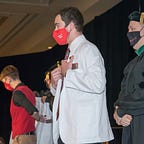First Ladies of American History
A look into three presidential spouses
 We often spend time in school or on our own learning about the presidents. Far less frequently do we take the time to glance into the lives and accomplishments of their spouses.
We often spend time in school or on our own learning about the presidents. Far less frequently do we take the time to glance into the lives and accomplishments of their spouses.
First ladies are rarely given their fair share of fame, especially when their husbands fall under the category of forgotten presidents.
In this article, let’s take a look into three randomly selected first ladies of American history. These generator-chosen first ladies are Hannah Van Buren, Julia Tyler, and Frances Cleveland.
Hannah Hoes Van Buren
Hannah Hoes was born March 8th, 1783, the daughter of Johannes Dircksen Hoes and Maria Quakenbush. Hannah grew up in Kinderhook, New York where her family resided in a Dutch community, the same one that her first cousin once removed and future husband did.
Not much is known about Hannah’s adolescence, but it is assumed that she was minimally educated in the community and grew up as many of the children did, speaking Dutch and assisting in the rural community’s affairs. In her youth, she and the future 8th president, Martin Van Buren, became childhood sweethearts.
When they both were 20 years old, Martin left Kinderhook to study law in New York City. When he returned a couple years later, Martin established his law practice. After a time, he and Hannah wed in 1807. Between 1807 and 1817, she and Martin would have five sons. Their sons were Abraham, born in Kinderhook, John, Martin Jr., and Winfield, all in Hudson, New York where Martin was serving as a county official, and lastly, Smith in Albany, New York. Unfortunately, their fourth son, Winfield Scott Van Buren, died in infancy in 1814.
In 1816, the family moved to the state capital of Albany for Martin’s term in the state senate. While in Albany, they hosted many of Martin’s friends and visitors. Hannah was said to be a very friendly, sociable, and an enjoyable woman. She devoted much of her time outside of their home to serving charitably in the local Presbyterian Church and in the community.
Unfortunately, Hannah’s time in Albany came to an end much too soon. She contracted tuberculosis and began deteriorating rapidly. By the time her fifth son was born in 1817, she was becoming especially weak and required the help of her niece to run the household.
Hannah would sadly succumb to her disease on February 5th, 1819 just before the age of 36.
Her husband and future president never remarried. When Martin stepped into the White House in 1837, it was without a first lady. He would remain this way for the first year and a half of his term until his daughter-in-law, Angelica, stepped into the role.
Hannah Hoes Van Buren, despite only living a short life, is remembered fondly for her generous and caring nature. It is a shame her presence was never felt in the White House.
Julia Gardiner Tyler
Julia Gardiner was born in 1820 on Long Island. She was the first daughter, and third child, of prominent New York politician and lawyer David Gardiner and Juliana McLachlan. From a young age, Julia was pampered in high society, taking trips to Europe and indulging in the royalties of political prominence.
As an adolescent, Julia was formally educated in New York, studying music, literature, history, and the like. Julia also enjoyed singing and playing the guitar, two hobbies that she carried with her throughout her life.
When she was around the age of 20, she and her sister were taken to Washington by their parents. As young, unmarried women, the Gardiner parents felt it was time for their daughters to take the next step towards family making.
While spending time in Washington, Julia met her future husband. In 1842, 10th President John Tyler invited Julia and her family into the White House. President Tyler’s wife, Letitia, had been paralyzed from a stroke and would pass away just a few months later. Following his wife’s death, Tyler proposed to Julia in 1843, though she did not accept.
The Gardiner and Tyler families would continue their courtship, however. In February of 1844, President Tyler, cabinet members, Julia and her father, and other socialites were on the naval vessel Princeton when a cannon exploded, killing Julia’s father, David, as well as other office holders.
Following the tragedy, President Tyler consoled the grieving Julia, winning her affection and hand in marriage. The pair were wed later that year on June 26th, 1844 in New York, John being 30 years older than his new wife.
Since Tyler’s term would end in 1845, Julia only served as first lady for eight months. Though her term was abbreviated, Julia was said to be a superb party hostess. She was one of the first presidential spouses to openly garner newspaper support to bolster her public image and promote her gatherings. In her characteristic satin and lace, she, along with family friend Dolley Madison, provided the capital city with countless balls and extravagant parties, surely putting her sophisticated upbringing to use. Outside of the social sphere, Julia dabbled in the political arena, actively campaigning for her husband’s policies, like the annexation of Texas, among House and Senate members.
When President Tyler left the White House in 1845, the two returned to John’s Virginia plantation. She and John would have five sons and two daughters following his presidency, adding to John’s eight children from his previous marriage. He and Julia would have David, John Alexander, Julia, Lachlan, Lyon, Robert, and Pearl over a 14-year period from 1846 to 1860, just two years before John’s death in 1862.
Julia remained a fervent defender of her husband’s political views after his time in office and following his death. When John supported secession before the Civil War, she supported it as well. John accepted a seat in the Confederate Congress, and she defended his decision, although he died shortly after taking it. During the Civil War, Julia spent time in the North and the South, along with a stint in Bermuda, joining other Confederate exiles.
Following wartime, she returned to New York until moving back to Washington in 1872 and then back to Virginia once again. Until the final days of her life, Julia remained an active socialite, spending time entertaining and campaigning for the Confederate cause. Julia Tyler would pass away on July 10th, 1889.
Julia Tyler is remembered as a fiercely loyal wife who loved the social atmosphere of Washington and all that came with it.
Frances Folsom
Frances Folsom was born on July 21st, 1864 in Buffalo, New York. She was the only living daughter of Oscar Folsom and Emma Harmon. Oscar was a lawyer and would later become a legal partner of Frances’ future husband, Grover Cleveland.
France’s father died when she was just nine years old. In her youth, Frances raised by her mother and her mother’s family, spending time with her cousins and even living with her grandmother during high school. Following high school, Frances attended Wells College and graduated in 1885.
Just one year after her college graduation, she was courted by and married to 22nd President Grover Cleveland during his first term on June 2nd, 1886. Cleveland, who had supported and spent time raising Frances, was now her husband. Grover was 27 years her senior and reportedly even purchased Frances’ first carriage when she was a baby.
The newlyweds were scrutinized in the public eye. This pressure resulted in the Clevelands purchasing a farm in Georgetown Heights where they spent most of their time, only living in the White House during the social seasons of November to December and February through April.
Following Grover’s defeat in the 1888 election, the pair left Washington for New York City. It was here that their first daughter, Ruth, was born in 1891. Their time in political retirement would not last, however, as Cleveland won a second term and the family moved back to Washington in 1893. While in the White House they had two more children, Ester and Marion, in 1893 and 1895, respectively.
When Frances first became the first lady back in 1886, she was only 21 years old. Though she was young, she quickly learned the ropes of the Washington scene, becoming wildly popular and a successful socialite. Frances became well-known for her Saturday socials where she invited working-class women into the White House, a practice that was quite unprecedented. Frances was an avid supporter of women in the Washington area and used her influence to support their careers and societal advancement. Throughout both of her stints as first lady, Frances used her social standing to entertain guests from all walks of life, as well as to advocate for Washington’s poorest citizens.
When the Cleveland’s left office for the second time in 1897, they moved to Princeton, New Jersey. It was here that the family would welcome two more sons, Richard and Francis. However, just a year after Francis’ birth in 1903, 12-year-old Ruth would sadly die of diphtheria and four years later, Grover would die as well. This sent Frances into a severe depression.
Frances continued holding her seat as a trustee of Wells College through all her tragedies, however, which led to her meeting and marrying an art history professor named Thomas Preston. The two wed in 1913 and spent a year in London before returning at the start of World War I. Once returning to the United States, Frances was active in the National Security League, a group dedicated to democracy and patriotism. She also spoke out against voting rights for women on the grounds that they were unsuccessful in politics and better set to serve charitable organizations, a stance that resulted in criticism of the previous first lady.
Until her death on October 29th, 1947, Frances remained active in the Needlework Guild, supplying clothing and linens during World War I and the Great Depression, as well as at Princeton University.
Frances Cleveland Preston is viewed as a very popular first lady who did a lot of good while in Washington. Her admired social effort was appreciated in the capital and left her with a great legacy.
Closing Thoughts
It can be very interesting to dive into the lives of the first ladies. Each has contributed to American history in their own way and carved out a unique legacy. Though they come from diverse backgrounds, each first lady has shared the common experience of serving as a presidential spouse, a position not many can boast.
Hannah Hoes, Julia Gardiner, and Frances Folsom were all born New Yorkers, but their lives were all very different. Yet, they all somehow ended up in the White House.
Special thanks to my girlfriend, Ellie, for suggesting this article’s topic.
Sources
“Frances Folsom Cleveland.” The White House, The United States Government, 20 Jan. 2021.
“Hannah Hoes Van Buren.” The White House, The United States Government, 15 Jan. 2021.
“Julia Gardiner Tyler.” The White House, The United States Government, 15 Jan. 2021.
National First Ladies’ Library, http://www.firstladies.org/.
